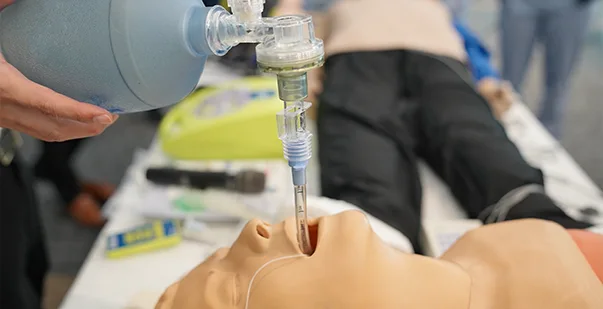A combination of CPR and advanced airway techniques helps save victims of cardiac arrest, the leading cause of death. Did you know that around 9 out of 10 people having cardiac arrests outside a hospital die within minutes?
To prevent this from happening, learning how to optimize airway management is key to ensure patient survival. This also impacts the chances of survival and recovery. It means you can save more lives by providing efficient critical care.
So, how is it possible to give CPR with an advanced airway? This guide will discuss the process and its techniques in detail.
Master ACLS Now
Get ACLS certified with confidence
Airway Management and its Importance in CPR
Chest compressions with advanced airway management are a crucial component of CPR. They ensure that the patient’s airway is always clear and open, enabling effective ventilation and oxygen delivery into vital organs inside the victim’s body. Proper airway management also helps maintain adequate oxygenation to prevent brain damage and increase the likelihood of survival.
Hence, maintaining an advanced airway CPR can help you improve patient outcomes in several ways. Its key objectives include:
Ensure Oxygen Delivery
Maintaining an open airway allows oxygen to circulate to vital organs and reach the lungs, supporting life-sustaining functions.
Prevent Aspiration
Clearing the airway reduces the risk of aspiration, where several foreign substances enter the lungs. This often leads to pneumonia or other complications.
Optimize Ventilation
Advanced airway management enables proper ventilation techniques to ensure adequate oxygen supply. The best example is mouth-to-mouth resuscitation or CPR bag mask device ventilation.
Read More: ACLS Certification in Texas
How is CPR Different With an Advanced Airway?
CPR is a lifesaving technique used in someone unconscious and not breathing. Sometimes, a person’s heart also stops beating if they experience a cardiac arrest. CPR helps supply oxygen-rich blood to vital organs in the body until the arrival of emergency medical services.
Yet, doing CPR with an advanced airway allows more efficient oxygen delivery. Here’s how.
You will find two advanced airways used during cardiac arrests. These include:
Endotracheal Tubes
Medical professionals insert an endotracheal tube (ET tube) through the mouth of the victim. It often passes past the vocal cords into the trachea. The tube provides a protected airway down to the lungs, which is clear and healthy. Several methods confirm ET tube placement inside a person’s body. These include:
- Visualization of the tube which passes through the vocal cords
- Listening to breath sounds over the lungs
- Detection of end-tidal carbon dioxide
Supraglottic Airways
Professionals insert supraglottic airways blindly through the mouth. These devices remain seated above the vocal cords in the hypopharynx. Common examples of these airways include laryngeal mask airway (LMA) or i-gel. These devices enable CPR with advanced airway techniques for oxygenation and ventilation of the lungs. Yet, they do not require the same level of advanced placement skills as endotracheal intubation.
How to Use a CPR Bag Mask Device with Advanced Airway
Sometimes, medical professionals prefer to use a bag-mask device to help with proper airway management. A bag-mask device consists of a reservoir bag attached to a mask. It helps provide positive-pressure ventilations during CPR.
Anyone can attach this bag mask to an oxygen source to provide 100% oxygenation during resuscitation. It can also be very difficult for a single person to use a bag-mask device.
That is why it is recommended that the bag mask device should be put to use only when there are two rescuers available. This helps in situations where an advanced airway device is in place during CPR.
Here are the steps to using a CPR bag mask device with advanced airway:
- Position yourself at the top of the head of the victim. This gives room for the second rescuer to provide compressions.
- Place the device’s mask on the victim’s face. Use the patient’s nose bridge to facilitate correct positioning.
- Use the E-C clamp technique to hold the bag mask in the correct position. Do this while you lift the jaw to obtain an open airway. Take the index finger of your non-dominant hand along with the thumb. This involves creating a ‘C’ form on the top of the mask. Lift the jaw of the victim with the rest of your fingers as a part of the E-C clamp technique.
- Squeeze the bag mask to deliver each breath for over 1 second. Watch for chest rise movements. If you do not see the chest rise, you may not have things sealed properly. Reposition the mask and try again in such situations. Take caution not to overinflate the lungs. Every breath should result in a natural and visible chest rise.
- Provide 2 ventilations after every 30 compressions you give to the victim. Provide one breath every 5-6 seconds (10-12 breaths/minute) if the patient has a pulse but is not breathing. Make sure to check for the pulse of the patient every 2 minutes. This involves starting with chest compressions if the victim loses their pulse.
Techniques for CPR with Advanced Airways
Several certified courses teach how is CPR different with advanced airway. With this, interested individuals must also learn the techniques for providing chest compressions in emergencies. These include:
Clearing and Opening the Airway
It involves four different techniques which include:
Head Tilt-Chin Lift Maneuver
This is a common method that helps open the airway in victims without suspected spinal injury. The steps involve placing one hand on the forehead and applying gentle backward pressure to the victim. Then the rescuer uses the fingertips of their other hand to lift the chin upward. Finally, the person tilts the head back to open the victim’s airway.
Jaw Thrust Maneuver
This method is used when spinal injury is suspected. The rescuer places their fingers behind the angles of the victim’s lower jaw and lifts with both hands. Then, they displace the jaw forward while avoiding tilting the head.
Visual Inspection
This process involves checking for visible obstructions around the mouth, such as vomit, blood, or foreign objects. The rescuer must remove all kinds of obstructed items with a finger sweep.
Suction Devices
These devices help clear the airway of fluids like blood or vomit that could obstruct breathing. Here, the responders use rescue breathing with advanced airway techniques to provide oxygenation to the victims. This involves using a bag mask or any other mouth-to-mouth ventilation after clearing the airway.
Ensuring Adequate Ventilation
Providing rescue breaths with advanced airway techniques is necessary when giving CPR to victims. This involves processes like:
Mouth-to-Mouth Ventilation
The steps include pinching the victim’s nose shut and taking a deep breath to seal the lips over theirs. Then, the rescuer must blow into the victim’s mouth until they see the chest rise. They must give each breath over one second and watch for the chest rise to ensure effective ventilation.
Mouth-to-Mask Ventilation
A pocket mask can help reduce the risk of disease transmission that often comes with a one-way valve. The rescuers can place the mask over the victim’s mouth and nose and create a seal. This enables them to breathe into the victims while analyzing chest rises.
Two-Handed Technique
With the two-handed technique, rescuers can maintain protection around the mask. This proves helpful in mouth-to-mask ventilation. It involves placing both thumbs on the top of the mask while using fingers to lift the victim’s jaw.
Quality Chest Compressions
Maintaining chest compressions is essential for effective CPR with advanced airway techniques. They help circulate blood and oxygen to vital organs to increase the chances of survival. The process includes:
Compression Technique
This technique involves applying pressure to the victim’s chest. Here, the rescuer uses both hands to interlock their fingers and work on the compression process. They must also use their upper body weight to perform compressions while keeping their arms straight. This must be at a depth of at least 5 cm for adults, which is around 2 inches. Around 100-120 compressions per minute is the perfect rate during this time.
Minimal Interruptions
The rescuer must also ensure that interruptions to chest compressions are minimized. Consistent compressions are the best way to manage blood flow.
Read More: Chest Compressions: The First Line Response
Considerations for CPR with an Advanced Airway
An emergency responder or rescuer must keep several things in mind when performing CPR with an advanced airway. When an advanced airway is in place, chest compressions can continue uninterrupted. This involves checking the following:
Pediatric Airway
Children with unique anatomical features need careful attention during airway management. So, the considerations include:
- Children usually have larger heads and tongues, but they tend to have smaller airways than adults. Proper positioning helps ensure the airway remains open in such cases.
- Rescuers must use a smaller mask for mouth-to-mask ventilation and be gentler with breaths and compressions. The best thing is to use two fingers for chest compressions in infants. This involves giving the victim a gentle head tilt to open their airway.
Trauma Victims
Airway management in trauma victims needs several precautions to avoid other injuries. The considerations include:
- The rescuer must use the jaw thrust maneuver if the victim has a spinal injury. They must do so without tilting the victim’s head to open the airway.
- They must also be vigilant about obstructions due to blood, teeth, or facial fractures. It involves using airway adjuncts or proper suction to maintain better patency.
Training for Learning CPR with an Advanced Airway
Practical training is essential to learn more about CPR and advanced airway management techniques. Several reputed organizations in the United States teach individuals about these techniques. This involves providing training programs like:
Courses and Simulations
CPR and first aid courses help you build confidence and proficiency in airway management techniques. This often involves using real-world scenarios, hands-on techniques, and mannequins for better understanding.
Regular Refreshers
Regular training and practice sessions help maintain skills and knowledge of CPR techniques. They also help individuals stay updated with the latest first aid guidelines and advanced airway techniques.
Final Thoughts on CPR with an Advanced Airway
Effective airway management helps with oxygenation and circulation during CPR and leads to a proper and efficient resuscitation process. Responders can improve their ability to deliver effective lifesaving care if they use CPR with an advanced airway technique.
Providing rescue breaths, chest compressions, and using advanced airway devices are also crucial parts of this process. Individuals can learn more about these techniques in CPR courses that teach airway management. This enables them to save the lives of victims in emergencies while waiting for further medical help.







